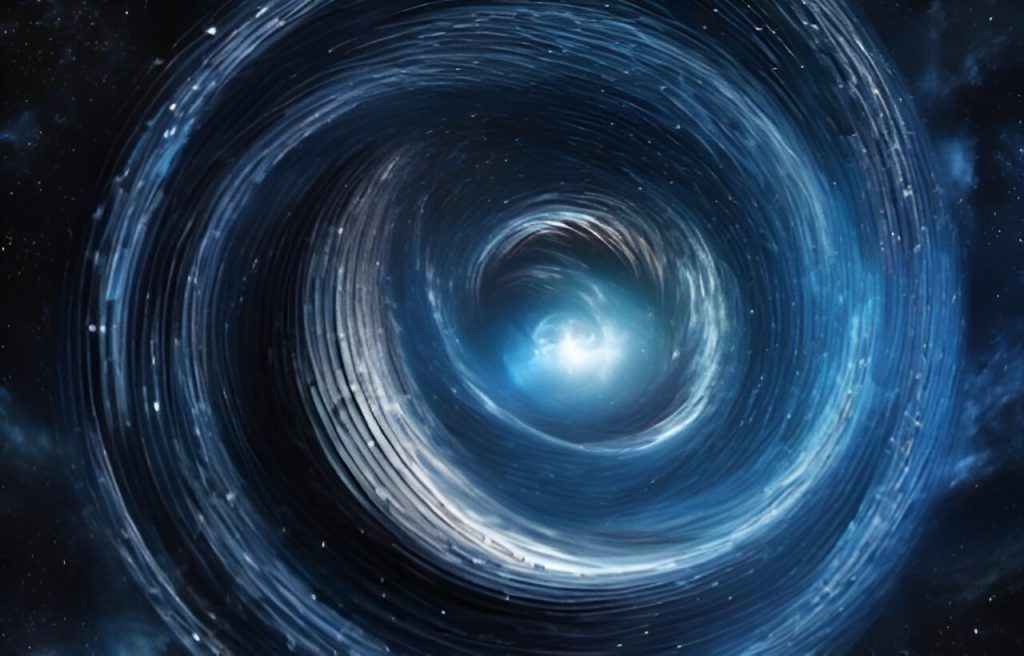AI-generated warp bubble collapse. Image credit: Katy Clough, AI tool pixlr.com
Imagine a spaceship moving not by engines, but by compressing space-time in front of it. That’s the stuff of science fiction, right? Well, not entirely. Physicists have been studying the theoretical possibility of “warp drives” for decades, but new research suggests that Published In Open Astrophysics Journal We go a step further and simulate the gravitational waves that could be emitted if such a drive were to fail.
Warp drives are a staple of science fiction, and in principle could propel a spaceship faster than the speed of light. Unfortunately, there are many problems with actually building a warp drive, including the need for a special material that has negative energy.
Other issues with warp drive metrics include the fact that they can be used to create closed time curves that defy causality, and from a more practical standpoint, that it would make it difficult for people on board to actually control and deactivate the bubble.
The new research is the result of a collaboration between gravitational physics experts from Queen Mary University of London, the University of Potsdam, the Max Planck Institute for Gravitational Physics (MPI) in Potsdam and Cardiff University. While they do not claim to have cracked warp drive’s code, they have used numerical simulations to explore the theoretical consequences of a warp drive “containment failure”.
Dr Katie Clough, from Queen Mary, University of London, first author of the study, said: “Warp drive is purely theoretical, but it is clearly described by Einstein’s theory of general relativity, Numerical simulation We can examine how they affect space-time. Gravitational waves“
Co-author Dr Sebastian Kahn, from Cardiff University’s School of Physics and Astronomy, adds: “Miguel Alcubierre developed the first warp drive solutions during his PhD at Cardiff University in 1994 and then worked at MPI in Potsdam. It is therefore natural for him to continue the tradition of warp drive research in the era of gravitational wave astronomy.”
The results are intriguing: Warp drive collapse would generate a distinct burst of gravitational waves that could be detected as ripples in space-time. Gravitational Wave Detector It typically targets the merger of a black hole and a neutron star, and unlike the chirp signals emitted by merging objects, this signal is a short, high-frequency burst that cannot be picked up by current detectors.
But there may be higher frequency instruments in the future, and while such instruments aren’t funded yet, the technology exists to build them. This raises the possibility that we could use these signals to look for evidence of warp drive technology, even if we can’t build it ourselves.
Dr Kahn cautions: “In our work, the initial shape of space-time is the warp bubble described by Alcubierre. Although we have demonstrated that an observable signal could in principle be found by future detectors, given the speculative nature of this work, this is not sufficient to drive instrument development.”
The study also delves into the energy dynamics of a collapsing warp drive, a process that sees the emission of waves of negative energetic matter, followed by alternating waves of positive and negative energy. This complex dance results in a net gain in energy throughout the system, and in principle could show other signs of collapse if the emitted waves interacted with normal matter.
This research pushes the boundaries of our understanding of exotic spacetimes and gravitational waves. Professor Dietrich comments: “For me, the most important aspect of this work is the novelty of accurately modelling the dynamics of negative energy spacetime and the possibility that this technique could be extended to physical situations to help us better understand the evolution and origin of the universe, or perhaps the avoidance of a singularity at the centre of the universe. Black Hole“
Dr Clough added: “It’s a reminder that theoretical ideas can inspire us to explore the universe in new ways. I’m sceptical that we’ll see anything, but I think it’s interesting enough to be worth looking at.”
The researchers plan to examine how the signal changes under different conditions. warp Drive the model and explore the collapsing bubbles traveling faster than the speed of light. Warp speed may still be a long way off, but the quest to unlock the secrets of the universe continues with every simulated collision.
For more information:
Katie Clough et al. “Something No One Has Seen Before: Gravitational Waveforms from Warp Drive Collapse” Open Journal of Astrophysics (2024). Translation: 10.33232/001c.121868. upon arXiv: DOI: 10.48550/arxiv.2406.02466
Journal Information:
arXiv
Provided by
Queen Mary, University of London
Quote: New Study Simulates Gravitational Waves from a Failed Warp Drive (July 29, 2024) Retrieved July 30, 2024 from https://phys.org/news/2024-07-simulates-gravitational-warp.html
This document is subject to copyright. It may not be reproduced without written permission, except for fair dealing for the purposes of personal study or research. The content is provided for informational purposes only.


